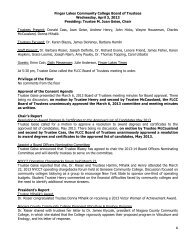Driving Economic Impact - Finger Lakes Community College
Driving Economic Impact - Finger Lakes Community College
Driving Economic Impact - Finger Lakes Community College
Create successful ePaper yourself
Turn your PDF publications into a flip-book with our unique Google optimized e-Paper software.
4<br />
New York community colleges mean<br />
jobs for NeW York<br />
<strong>Community</strong><br />
colleges have long<br />
been heralded as<br />
essential resources,<br />
and as the economy continues<br />
its climb, they are also a vital<br />
link to the job market. Because<br />
they are affordable, accessible<br />
and offer a wide range of job-training<br />
programs, they are helping workers<br />
meet the post-recession demand<br />
for different sets of job skills.<br />
“<strong>Community</strong> colleges helping to fuel job market,”<br />
Democrat and Chronicle, Rochester,<br />
January 16, 2011<br />
President Barack Obama<br />
has called community<br />
colleges the “gateway for<br />
millions of Americans to<br />
good jobs and a better life.”<br />
The Obama Graduation Initiative calls for<br />
community colleges to turn out five million<br />
more graduates by 2020, making the U.S.<br />
the nation with the highest rate of college<br />
graduates once again.<br />
New York’s<br />
<strong>Community</strong> <strong>College</strong>s:<br />
Give 246,000 SUNY students access to an<br />
education that prepares them for jobs or transfer<br />
to a four-year school.<br />
Know the employment needs in their communities and<br />
move fast to fill them. Nearly 80 percent of community<br />
college graduates remain local.<br />
Provide business and industry training to approximately<br />
700,000 people per year. 1<br />
Are in the best position to educate tomorrow’s<br />
work force. By 2018, New York will create 2.8 million<br />
new or replacement jobs, and 63 percent of all jobs<br />
in New York (6.1 million jobs) will require some<br />
post-secondary training beyond high school. 2<br />
Provide opportunity to lower-income New Yorkers,<br />
who have been losing ground during the recession.<br />
Increase a graduate’s annual income by<br />
16 to 27 percent over the course of a lifetime. 3<br />
Lead the state in preparing students for jobs in the<br />
semi-conductor, green energy, health care, information<br />
communication technology, and emergency<br />
management fields.<br />
Generate a 7.7 percent rate of return to state<br />
and local governments on their financial support<br />
for community colleges. 4<br />
Help New York save $81 million per year in social<br />
costs, including savings associated with improved<br />
health, reduced crime, reduced social services,<br />
and lower unemployment. 4<br />
1. State University of New York<br />
2. Help Wanted: Projection of Jobs and Education Requirements<br />
Through 2018, Georgetown University Center on Education<br />
and the Workforce<br />
3. Kolesnikova (2009), Kane and Rouse (1995), Leigh and Gill (1997)<br />
4. EMSI (January 2011)

















